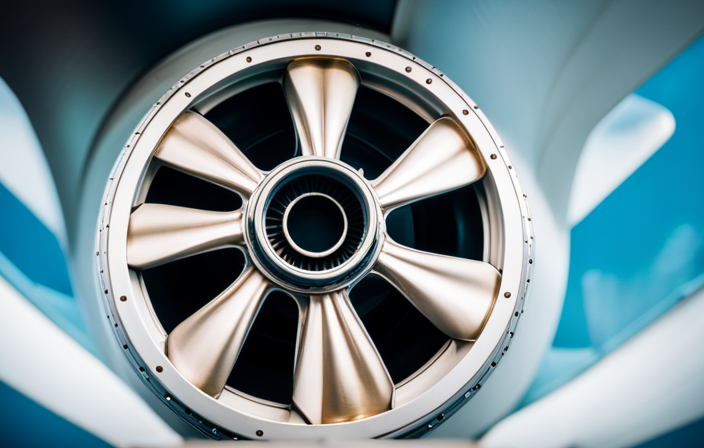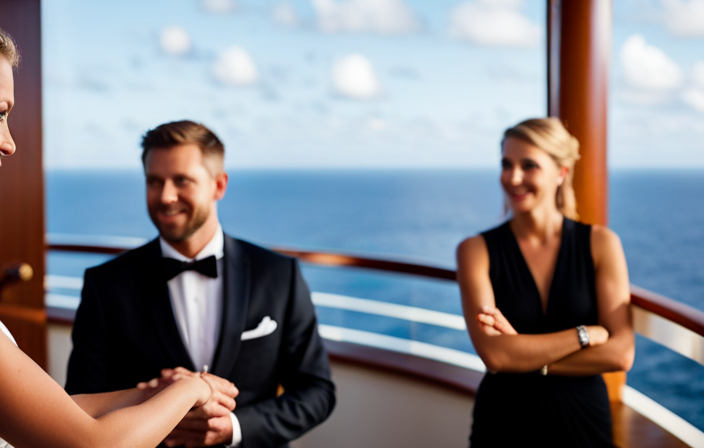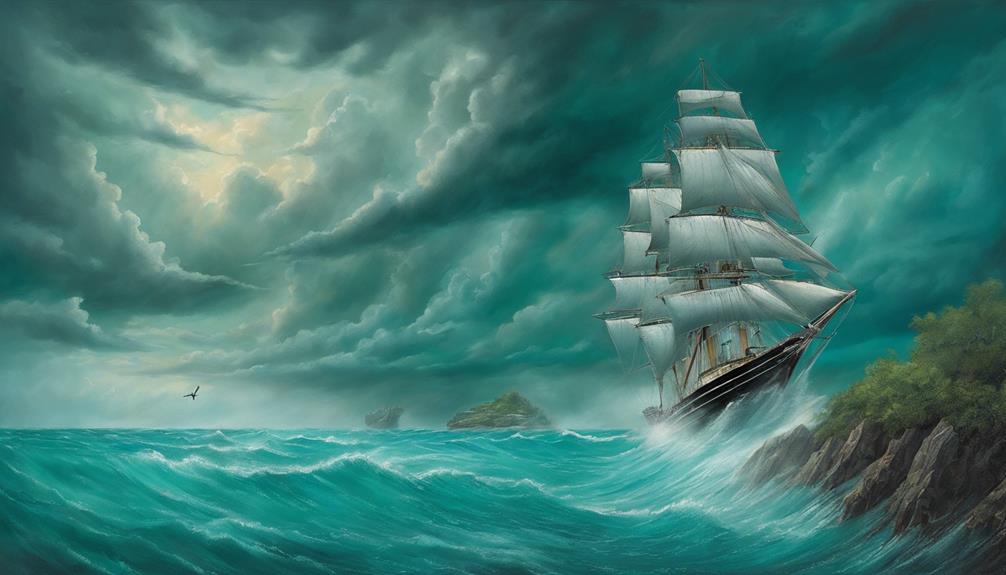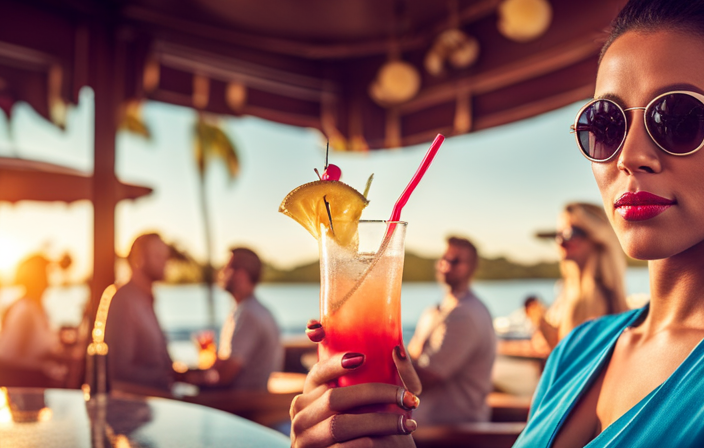Ever curious about what secrets lie beneath the grand facade of a cruise ship? Prepare yourself for an exhilarating adventure as I guide you through the mysterious depths of the ocean!
Picture this: a colossal vessel gliding through the ocean, its hull slicing effortlessly through waves as it carries thousands of passengers and crew members to their dream destinations. But what exactly does the bottom of a cruise ship look like?
Brace yourself for an exploration into the intricate world below deck, where technology meets nature in a delicate balance. From the robust structure and anti-fouling coatings that protect against corrosion and marine life, to the powerful propulsion systems propelling these behemoths forward, we’ll uncover every hidden secret lurking beneath those sparkling blue waters.
So grab your diving gear and get ready for an underwater adventure like no other!
Key Takeaways
- The bottom of a cruise ship is subject to regular inspections and maintenance techniques to ensure its structural integrity and longevity.
- Cleaning processes involve the use of high-pressure water jets and specialized brushes to remove marine growth and enhance fuel efficiency.
- The condition of the ship’s bottom surface impacts fuel efficiency, with a clean and smooth surface improving performance and reducing fuel consumption.
- Future innovations, such as low friction paints and advanced waste management systems, aim to create a sustainable and eco-friendly sailing experience while minimizing the environmental impact of cruise ships.
The Structure and Design of a Cruise Ship’s Hull
Take a moment to imagine yourself standing on the shore, gazing at the magnificent cruise ship before you, and marveling at the sleek and sophisticated design of its hull.
The underwater construction techniques employed in building the bottom of a cruise ship are truly remarkable. To withstand the harsh conditions of constant exposure to water, corrosion prevention measures are meticulously implemented.
The hull is carefully constructed using high-quality materials such as steel or aluminum alloys that possess exceptional strength and resistance against rust. Special coatings are applied to protect against corrosion caused by saltwater and marine organisms. These coatings act as a barrier, preventing any unwanted substances from penetrating the hull’s surface. They also enhance hydrodynamic performance, reducing drag and increasing fuel efficiency.
Transitioning into the subsequent section about ‘the anti-fouling coating and protection systems,’ it is essential to understand how these additional measures ensure optimal maintenance and longevity for a cruise ship’s hull without compromising its efficiency.
The Anti-fouling Coating and Protection Systems
Installed on the underside of a cruise ship is an advanced anti-fouling coating and protection system. This system plays a crucial role in preventing the accumulation of marine organisms and maintaining optimal vessel performance. It includes eco-friendly coatings that deter biofouling. These coatings are formulated with environmentally friendly ingredients that act as barriers against the attachment and growth of algae, barnacles, and other unwanted organisms on the ship’s hull. By preventing biofouling, they help reduce drag, maintain fuel efficiency, and prolong the life of the ship’s structure.
In addition to eco-friendly coatings, the protection system incorporates other measures. These measures include sacrificial anodes and impressed current systems for corrosion prevention. Sacrificial anodes made from zinc or aluminum are strategically placed on the hull to attract corrosion away from vital components. Impressed current systems use electrical currents to create a protective barrier against corrosion.
Transitioning into the subsequent section about ‘the propulsion system and underwater machinery’, it is important to note that while anti-fouling coatings play a significant role in protecting the ship’s hull, they do not directly affect the operation of propulsion systems or underwater machinery.
The Propulsion System and Underwater Machinery
The powerful engines and intricate machinery below the water’s surface propel the cruise ship forward, allowing it to navigate through the vast ocean with ease. The propulsion system and underwater machinery are essential components that ensure the ship’s smooth operation.
Here are some key details about these systems:
-
Propellers: These rotating blades provide thrust by pushing water backward, propelling the ship forward.
-
Rudder: This movable vertical plate controls the direction of the ship by redirecting the water flow created by the propellers.
-
Thrusters: These auxiliary propellers help in maneuvering and positioning the ship accurately.
-
Underwater Noise Pollution: The constant functioning of these mechanisms can contribute to underwater noise pollution, affecting marine life.
Additionally, proper maintenance of these systems is crucial to prevent marine pollution from ship waste like oil leakage or discharge.
Now let’s explore another important aspect of a cruise ship’s structure – ballast tanks and stabilizers – which play a vital role in maintaining stability and balance during voyages.
The Ballast Tanks and Stabilizers
Ballast tanks and stabilizers are the unsung heroes of a cruise ship. They work behind the scenes to ensure a smooth and stable voyage. The ballast tanks, located in the lower part of the ship, adjust the ship’s weight distribution by filling them with water or emptying them. This helps maintain stability in rough seas and prevents excessive rolling or pitching. Regular ballast tank cleaning is essential for preventing corrosion and maintaining efficiency.
Stabilizers play a crucial role in reducing the ship’s motion caused by waves. They consist of retractable fins on either side of the hull. These fins can be adjusted to counteract rolling motions, depending on sea conditions. Stabilizer efficiency depends on factors such as size, design, and optimal positioning on the ship’s hull.
With ballast tanks ensuring balance and stabilizers minimizing motion, passengers can enjoy a smoother sailing experience aboard a cruise ship. Now, let’s delve into the fascinating world of underwater lights and communication systems without skipping a beat.
The Underwater Lights and Communication Systems
Underwater exploration has led to remarkable discoveries in marine archaeology, thanks in part to sophisticated underwater lights and communication systems.
These systems are strategically placed on the bottom of cruise ships to enhance visibility and facilitate communication with divers and underwater vehicles.
The lights are designed to withstand high water pressure and provide optimal illumination for exploring sunken treasures or studying marine life.
Alongside these lights, advanced communication systems enable seamless interaction between divers and surface personnel, allowing for real-time data exchange and coordination during expeditions.
As we dive further into the fascinating world beneath the surface, let’s explore how the sonar and navigation equipment aids in our quest for knowledge about the ocean depths.
The Sonar and Navigation Equipment
Navigating through the depths of the ocean with sonar and navigation equipment is like embarking on a thrilling, high-tech treasure hunt. Sonar technology plays a crucial role in detecting underwater objects and mapping the seafloor. By emitting sound waves and analyzing their echoes, it provides a detailed picture of the ship’s surroundings. Navigational instruments, such as radar and GPS, work together with sonar to ensure precise positioning and accurate course plotting. To give you an idea of the complexity involved, consider this table:
| Instrument | Purpose | Technology Used |
|---|---|---|
| Sonar | Object detection | Sound waves |
| Radar | Detecting other vessels | Radio waves |
| GPS | Positioning | Satellite signals |
These instruments form an integrated system that enables safe and efficient navigation. Transitioning into the subsequent section about ‘the marine life and ecosystems found around the ship,’ we can now explore how these advanced technologies coexist with nature’s wonders.
The Marine Life and Ecosystems Found Around the Ship
As you dive into the depths of the ocean, a mesmerizing tapestry of marine life and vibrant ecosystems unfolds before your eyes, like an underwater symphony of colors and movement. The marine life surrounding a cruise ship is a delicate balance that showcases both the fragility and resilience of our oceans.
-
Marine Conservation:
-
Preservation efforts: protecting vulnerable species from harm caused by ship traffic.
-
Environmental impact assessments: determining potential effects on local ecosystems during ship construction or maintenance.
-
Waste management: implementing strategies to minimize pollution and maintain water quality.
-
Underwater Exploration:
-
Biodiversity studies: documenting various species that inhabit the area around the ship.
-
Habitat mapping: understanding how different ecosystems interact in this unique environment.
-
Research dives: conducting experiments to analyze patterns and changes within the marine ecosystem.
Understanding these aspects is crucial for sustainable travel. However, maintaining and cleaning processes for the ship’s bottom also play a vital role in preserving this delicate balance.
The Maintenance and Cleaning Processes for the Ship’s Bottom
After exploring the fascinating marine life and ecosystems that thrive around the ship, let’s dive into the maintenance and cleaning processes for the ship’s bottom.
Ensuring the longevity and efficiency of a cruise ship requires meticulous attention to detail in its upkeep. Regular maintenance techniques employed involve inspecting for hull damage, corrosion, or any potential issues that may compromise the ship’s structural integrity.
Cleaning equipment such as high-pressure water jets and specialized brushes are utilized to remove accumulated marine growth like barnacles and algae from the hull surface. This is essential as these organisms can increase drag, reducing speed, fuel efficiency, and overall performance.
By maintaining a clean and smooth bottom surface, cruise ships can enhance their fuel efficiency while minimizing their impact on environmental sustainability.
Transitioning into our next section, let’s explore how this maintenance impacts both fuel efficiency and environmental sustainability without compromising safety.
The Impact of the Ship’s Bottom on Fuel Efficiency and Environmental Sustainability
Imagine how much more efficiently you can sail through the ocean and reduce your environmental impact when the ship’s bottom is clean and smooth. Fuel efficiency improvements and sustainability measures are crucial in ensuring a greener future for cruise ships. By optimizing the design and maintenance of a ship’s bottom, significant reductions in fuel consumption can be achieved. The hull form, coatings, and propulsion systems play a vital role in enhancing fuel efficiency. For instance, hydrodynamically optimized hull forms minimize drag, while advanced antifouling coatings prevent marine growth that increases resistance. Additionally, innovative propulsion technologies like electric or hybrid systems further enhance sustainability by reducing emissions.
To emphasize the importance of these improvements, consider the following table:
| Traditional Bottom | Optimized Bottom | |
|---|---|---|
| Fuel Consumption | High | Reduced |
| Emissions | High | Lowered |
| Environmental Impact | Significant | Minimized |
These fuel efficiency improvements and sustainability measures not only benefit cruise operators but also contribute to preserving our oceans. In the subsequent section, we will explore future innovations and technologies for cruise ship bottoms without skipping a beat.
The Future Innovations and Technologies for Cruise Ship Bottoms
Get ready to be amazed by the future innovations and technologies that will revolutionize the way you sail through the ocean and leave a minimal environmental footprint.
Future cruise ship designs are focused on incorporating advanced technologies that aim to prevent marine pollution. One such innovation is the use of special coatings on the bottom of cruise ships, which help reduce fuel consumption and minimize emissions.
These coatings, known as low friction paints or hull coatings, create a smooth surface that reduces drag and resistance against water flow. By reducing drag, these coatings improve fuel efficiency and decrease greenhouse gas emissions.
Additionally, future cruise ship designs may also incorporate advanced waste management systems that treat wastewater onboard to prevent any harmful discharge into the ocean.
The integration of these innovative technologies ensures a sustainable and eco-friendly sailing experience for all passengers while protecting our precious marine ecosystems from pollution.
Frequently Asked Questions
How often does a cruise ship’s hull need to be inspected and maintained?
Cruise ship hulls require regular inspection and maintenance to ensure their integrity. Inspection procedures involve thorough checks for corrosion, cracks, and other structural issues. The frequency of these inspections depends on various factors like vessel age and operating conditions.
Are there any specific regulations or guidelines for the design and construction of a cruise ship’s hull?
There are regulatory requirements and hull design standards that govern the construction of cruise ship hulls. These guidelines ensure the structural integrity, stability, and safety of the vessel in various operating conditions.
What materials are commonly used in the construction of cruise ship hulls?
When constructing cruise ship hulls, common materials used include steel, aluminum, and fiberglass. Steel offers strength and durability but is heavy. Aluminum is lightweight but less strong. Fiberglass combines strength and lightness but can be costly to repair.
How do cruise ships prevent corrosion and damage to their hulls?
To prevent corrosion and damage to cruise ship hulls, cathodic protection systems are used. These systems involve the installation of sacrificial anodes that corrode instead of the hull. Anti-fouling coatings are also applied to prevent marine organisms from attaching and causing damage.
Are there any safety measures in place to protect marine life from the impact of cruise ship bottoms?
To protect marine life from the environmental impact of cruise ship bottoms, safety measures are in place. These include specialized coatings to reduce friction and minimize damage, as well as strict regulations for waste disposal and ballast water management.
Conclusion
In conclusion, exploring the bottom of a cruise ship reveals a world of intricate design and technology. From the hull structure to the anti-fouling coating, every aspect is carefully crafted to ensure efficiency and protection.
The underwater machinery, ballast tanks, and stabilizers work seamlessly to provide stability and maneuverability. The underwater lights and communication systems enhance safety while also adding a touch of beauty.
It is fascinating to witness the diverse marine life that thrives around the ship, creating its own ecosystem. Maintaining and cleaning the ship’s bottom is crucial for fuel efficiency and environmental sustainability.
As technology advances, we can expect future innovations that will further enhance cruise ship bottoms, making them even more efficient and environmentally friendly.
So next time you embark on a cruise journey, take a moment to appreciate the marvel beneath your feet!










